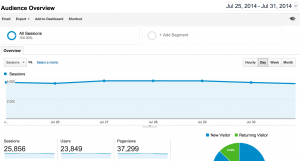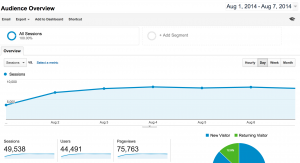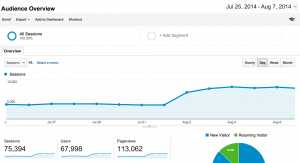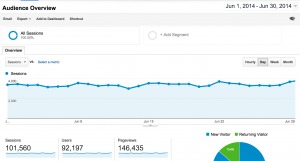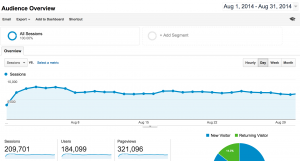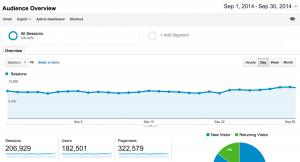This is a case study on how I doubled organic traffic to an existing website from 100,000 visits per month to over 200,000 visitors per month, overnight, using technical SEO and the osmosis technique.
This was done using a strategy that involves absorbing another operating website’s content, rankings, and ultimately traffic.
Here’s the website’s traffic the week before, from July 25, 2014 to July 31, 2014:
And here’s the same website’s traffic the week after, from August 1, 2014 to August 7, 2014:
And here’s what the lift looks like:
Here’s the website’s traffic for the month of June 2014 (prior to absorbing the other site):
And here’s traffic for August 2014 (with the osmosis taking place on 8/1/14):
Want results like these for your website? Request a SEO analysis right now!
Table of Contents
So What is SEO By Osmosis
Just like in science where one membrane absorbs the property’s and molecules of another membrane during osmosis, this SEO strategy involves absorbing the content and rankings of another website so as to inherit it’s organic traffic.
So how do you do this?
The concept itself is actually very simple, but the implementation needs to be spot on or you could torch both websites, at least temporarily.
The process involves using one of two methods to essentially swallow the content of the other website, and then inherit it’s organic rankings and thus traffic.
If you’re not an advanced professional, it’s best you involve an experienced team of SEO experts and developers prior to applying this technique. That way you’ll be able to minimize the eventual damages caused by a domain migration.
How To Absorb All The Traffic
As mentioned earlier there is 2 ways to do this:
- Using 301 re-directs, or
- Using cross-site canonical tags
Both involve the same process of preparing for the cut-over; the content needs to be duplicated on the destination website by being uploaded to the destination site’s database.
If you’re going to use 301’s then it’s best to try to replicate the URL structure of the old site’s pages and if possible place these all in one new directory, so you only have to write one mod rewrite statement to repoint all of these URL’s to their new home.
In the example I use for this post I used a sitewide 301 re-direct to sub-directory on the destination website.
If you are going to use cross-site canonical tags the process has a few extra steps:
- The canonical tag needs to be added into the head of every page that you will be absorbing.
- Generate a fresh sitemap to make sure all pages are included.
- Brute-force submit this sitemap through webmaster tools 3+ times each day to forge Google to crawl and index those canonical tags.
- Keep an eye on the URL’s ranking for those pages and once you see 75%+ you need to set the old domain to return a 403 Forbidden Error.
What Makes A Good Osmosis Website
Finding a website that is a good fit for this strategy has a lot of implications, for example:
- The website needs to already have sufficient natural rankings and a sustainable base of organic traffic, although sufficient is a relative term here and will vary depending on your comfort level for risk and investment.
- The website should have content that is at least tangential or in some way related to that of the target destination website.
- Ideally the website will be built on a stack using the same kind of database, for example if I was going to do this for *this* website I would look for a site running a MySQL database (even more ideal would be if it was wordpress), so I could download and then simply upload to my database.
Finding websites at this scale (~100,000+ visits per month) available for acquisition is not easy, it’s much more likely that you will be able to find sites in the 10-30k visit per month range that you will be able to pick up for a few thousand dollars based on:
- Age of the domain
- Authority of domain (PageRank / DA)
- Number of unique visitors
- Monetization and revenue
Is This Traffic Sustainable?
You tell me, here’s the traffic numbers for September 2014:
Something To Be Aware Of..
It seems there is a somewhat rampant problem in Google with continuing to index old domains that have been 301’d, here are a few examples:
DEAR Google - WTF is keeping old 301 redirected pages in the index all about? 88K for one site.
— Rishi Lakhani (@rishil) September 23, 2014
However, the meta attributes, i.e. page titles and meta descriptions as well as URL targets (destinations) are all pointing to the correct version and bringing click-throughs to the right place, so in terms of traffic this still works – but in terms of continuity of user experience, this seems way off.
With that said in my experience this problem is less significant when you go the cross-site canonical route to absorb the traffic. Thank you to Ross Hudgens for providing me with Rishi’s tweet and examples.
Do you want to make a domain change but fear of losing traffic? Contact us for an SEO analysis!
For Future Updates
I plan to continue to acquire more sites and fold them into this same site to see if I can grow through traffic acquisition to over 1,000,000 visitors per month. To stay tuned on my progress (including sites I’m looking at buying and details on traffic and bids/offers) that I won’t share here, join my mailing list (it’s free).
Lastly, if you enjoyed this post, and especially if you didn’t, please consider taking a moment to leave a comment – I use comments as my number 1 indicator on how well a post topic or concept resonates with readers.
Thank you.
If you’re dealing with an ecommerce website and want to apply the osmosis technique, it’s important that you cover the ecommerce SEO for advanced users in my previous posts.


